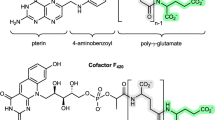Abstract
IN a recent paper in Nature, Hanes et al.1 postulated a γ-glutamyl transfer mechanism in peptide bond synthesis. It is suggested that the amino-acid forms its first peptide bond with the α-carboxyl of glutamic acid by displacing the cysteinyl glycine from glutathione. The amino-acid, now peptide bound, could be further transferred to other peptides. The concept is strengthened in view of the universal and yet unexplained presence of glutathione in all living tissues, the great significance of ‘transferring’ reactions in biochemistry, and the need for some hypothesis to shed light on the mechanism of protein synthesis. Experiments to test this hypothesis are described in this communication.
This is a preview of subscription content, access via your institution
Access options
Subscribe to this journal
Receive 51 print issues and online access
$199.00 per year
only $3.90 per issue
Buy this article
- Purchase on Springer Link
- Instant access to full article PDF
Prices may be subject to local taxes which are calculated during checkout
Similar content being viewed by others
References
Hanes, C. S., Hird, F. J. R., and Isherwood, F. A., Nature, 166, 288 (1950).
LeQuesne, W. J., and Young, G. T., J. Chem. Soc., 1959 (1950).
Peterson, E. A., and Greenberg, D. M., J. Biol. Chem., 194, 359 (1952).
Kit, S., and Greenberg, D. M., Cancer Res., 11, 495, 500 (1951).
Author information
Authors and Affiliations
Rights and permissions
About this article
Cite this article
HENDLER, R., GREENBERG, D. Reported Gamma Glutamyl Activation of Peptide-Bond Synthesis. Nature 170, 123–124 (1952). https://doi.org/10.1038/170123c0
Issue Date:
DOI: https://doi.org/10.1038/170123c0
This article is cited by
Comments
By submitting a comment you agree to abide by our Terms and Community Guidelines. If you find something abusive or that does not comply with our terms or guidelines please flag it as inappropriate.



